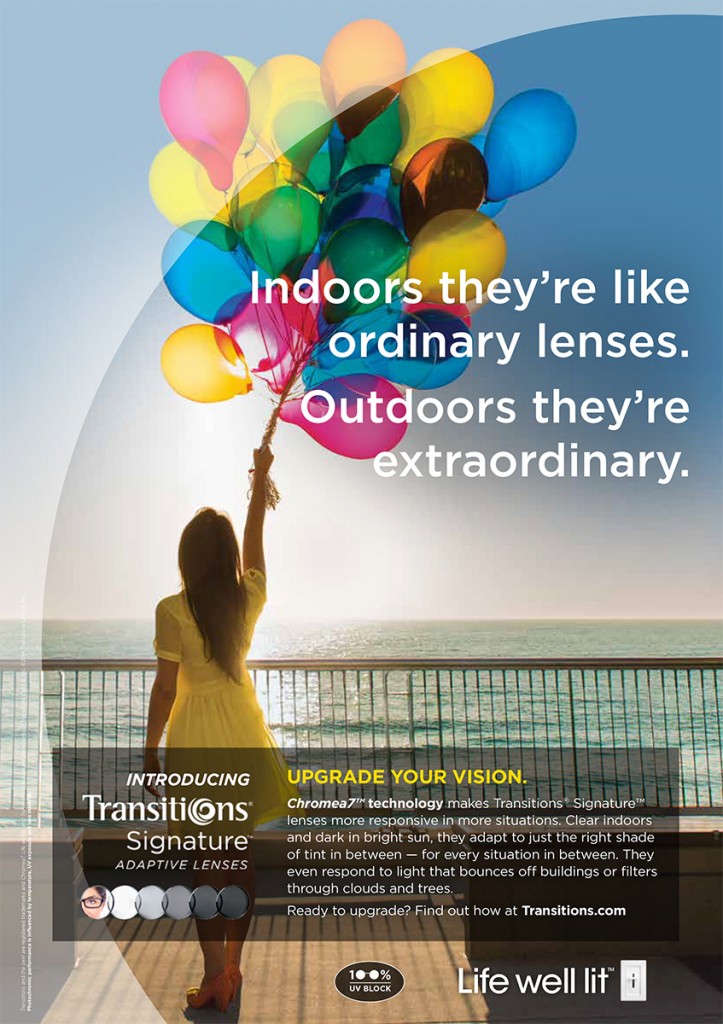(Article credit to Gary Heiting OD and AllAboutVision.com)
Photochromic lenses are eyeglass lenses that darken automatically when exposed to sunlight, then fade back when you return indoors. In most cases, photochromic lenses are clear (or nearly clear) indoors and darken to a medium sun tint outdoors. But there are exceptions.
Because the most popular photochromic lenses sold in the United States are made by Transitions Optical, many people — including some eye care practitioners — mistakenly call all photochromic lenses “transitions lenses” or “transition lenses.” But there are many brands of photochromic lenses offered by different lens manufacturers (see below).
Other generic terms sometimes used for photochromic lenses include “light-adaptive lenses” and “variable tint lenses.

The molecules responsible for causing photochromic lenses to darken are activated by the sun’s ultraviolet radiation. Because UV rays penetrate clouds, photochromic lenses will darken on overcast days as well as sunny days. But because the windshield and window glass of cars and trucks blocks most UV rays, photochromic lenses typically won’t get as dark inside a vehicle as they do outdoors.
Photochromic lenses are available in nearly all lens materials and designs, including high-index lenses, bifocals and progressive lenses. An added benefit of photochromic lenses is that they shield your eyes from 100 percent of the sun’s harmful UVA and UVB rays.
Because a person’s lifetime exposure to sunlight and UV radiation has been associated with cataracts later in life, it’s a good idea to consider photochromic lenses for children’s eyewear as well as for eyeglasses for adults. Polycarbonate is the safest lens material for kids, providing up to 10 times the impact resistance of other lens materials.
Though photochromic lenses cost more than clear eyeglass lenses, they offer the convenience of reducing the need to carry a pair of prescription sunglasses with you everywhere you go.
Indoor/Outdoor Photochromic Lenses
Popular brands of all-purpose, indoor/outdoor photochromic lenses sold in the United States include:
Transitions Signature (Transitions Optical) — Transitions Signature lenses (also called Transitions Signature VII lenses) represent the seventh generation of Transitions photochromic lenses. Introduced in 2014, Transitions Signature lenses are available in a wide variety of lens materials and designs, in either a gray or brown light-adaptive tint. The lenses are clear indoors, get 15 to 21 percent darker outdoors than previous Transitions lenses, and are preferred 2-to-1 over previous-generation Transitions lenses, according to the company.

These lenses are primarily for outdoor wear and are not as clear indoors as other photochromic lenses, but they provide extra comfort in bright sunlight and behind the wheel:
Transitions XTRActive (Transitions Optical) — These lenses are darker than Signature VII lenses (both indoors and outdoors) for wearers who are light-sensitive indoors and desire a darker lens when driving and outdoors. Available in gray tint only.
Transitions Vantage (Transitions Optical) — These lenses have a light tint indoors and become polarized as they darken outdoors for greater glare control in bright, reflective conditions. Transitions Vantage lenses do not darken inside a vehicle, however. Available in gray tint only.
Transitions Drivewear (Transitions Optical and Younger Optics) — These are polarized sunglasses specifically designed for optimum driving vision in variable daylight conditions. Depending on lighting conditions, Drivewear lenses change from green/yellow to copper to dark red/brown. Because they remain significantly tinted at all times, these photochromic lenses are not recommended for indoor or night-time wear.